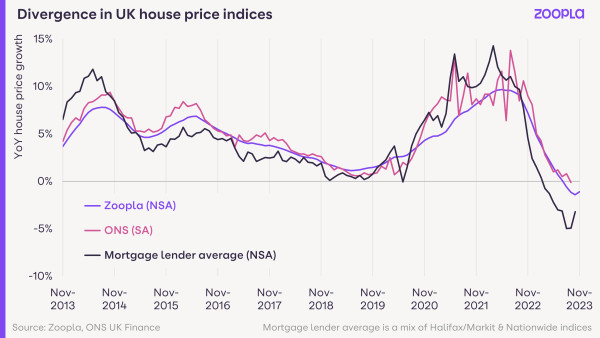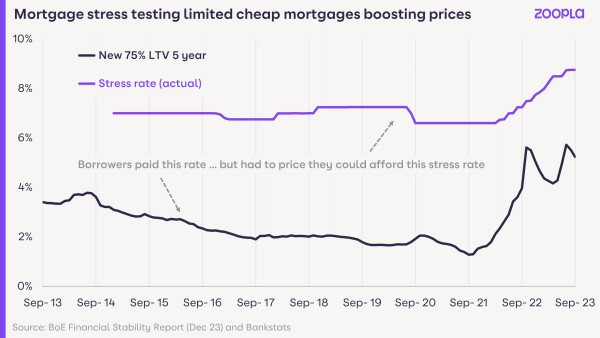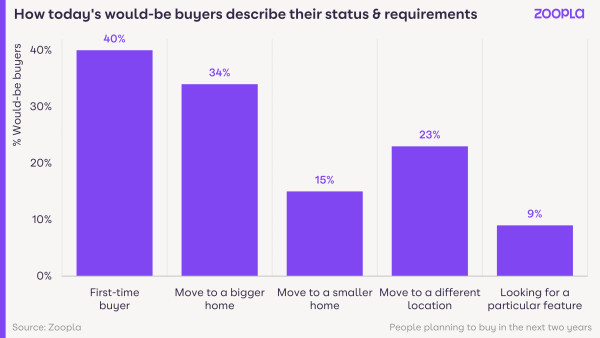House price inflation running at -1.1% as market sentiment improves with demand up and more sales agreed. Get the latest in our December House Price Index with Richard Donnell.
Sales hold up in Q4 2023, providing support for prices
The final weeks of 2023 have recorded above average levels of new sales, 17% higher than a year ago.
Market sentiment is improving due to rising incomes and an initial decline in mortgage rates. Demand is also 19% higher than a year ago.
An increase in available supply, up a quarter on last year, is also boosting choice and supporting sales. Buyers and sellers are becoming more aligned on pricing, reducing the downward pressure on values.
Our headline UK house price index has recorded a slower pace of annual price decline at -1.1% in November 2023, down from +7.2% a year ago.
And price falls have now moderated across all regions and countries of the UK.
House price indices can show varied trends when the market turns
UK house price indices track well over time, but they tend to separate at key moments as the volume and mix of sales changes.
The Zoopla house price index is based on the largest dataset of any UK house price index.
It has performed inline with the ONS house price index, with both series including cash and mortgaged sales.
In 2023, cash purchases look set to account for a third of all sales and are therefore an important source of pricing evidence.
The average price of a cash purchase is 10% lower than the average mortgage funded sale. This makes cash purchases slightly more affordable, especially since there is no mortgage process or valuation required to enable a sale.
Mortgaged sales are on track to be 30% lower over 2023 as higher mortgage rates hit demand. Because of this, mortgage lenders’ house price indices responded quickly to weaker demand, recording steeper price falls over 2022 Q4 and 2023 H1.
However, the annual growth rate in house prices recorded by lenders has improved in recent months as market activity and pricing stabilises, bringing it back towards the Zoopla/ONS series.

Why haven’t house prices fallen more in 2023?
History suggests that mortgage rates rising from 2% to over 5% would have led to larger price falls than what has been recorded over 2023.
There are several reasons why prices have defied the predictions of larger falls:
1. The strength of the labour market has been an important factor along with high growth in average earnings.
2. Lenders have also pursued forbearance policies to support households struggling with repayments, which has limited the number of forced sellers.
3. And perhaps the most important factor of all: the introduction of tougher mortgage affordability testing for new borrowers since 2015.
These regulations were designed to stop households taking on excessive debts at a time of low mortgage rates.
They have stopped a major housing overvaluation and built resilience for many households to manage the transition to higher mortgage rates.
While mortgage rates got as low as 1.3% in late 2021, all new mortgage borrowers had to prove to their bank that they could afford a 6-7% stressed mortgage rate to get the loan (see chart below).
Banks were also limited to 15% of new business at high loan to income ratios over 4.5x.

These regulations have effectively capped buying power for home buyers.
They require the borrower to have a higher income to buy and put down a larger deposit, which is especially true in higher value housing markets.
ONS data shows that first-time buyers in London put down an average deposit of £145,000 in 2022, compared to £26,000 for those buying in the North East.
Today, lenders are stress testing new borrowers at close to 9% despite mortgage rates starting to fall.
This regulatory constraint on buying power is one reason we believe house prices are unlikely to rise in 2024, even as base rates start to fall later in the year.
First-time buyers to remain largest buyer group in 2024
Despite the affordability challenges facing first-time buyers, they will be the largest group of would-be buyers in the next 2 years.
Our latest consumer survey of home moving intentions found that 40% of people looking to buy a home in the next 2 years are first-time buyers.
The rapid growth in rents continues to motivate this group – average rents have risen faster than average mortgage repayments over the last 3 years – despite the need for higher deposit levels.
Upsizers account for a third of would-be buyers in the next 2 years, who will typically be buying a larger home that will require a larger mortgage.
This group has been biding their time in 2023, waiting for the outlook on the economy and mortgage rates to become clearer. The trajectory for mortgage rates and getting better value for money will be key considerations for upsizers in 2024.

Buyers look further afield for better value
Almost a quarter of would-be home movers say they are looking to move to a different location.
A high proportion of home moves tend to be limited to within local areas – the average distance buyers are looking to move when searching on Zoopla is 4.3 miles.
However, in the face of higher borrowing costs and the search for value, one of the key trends for 2024 will be buyers continuing to look further afield in search of better value.
This is particularly the case in high value housing markets where upsizing is expensive.
Our data shows that almost half of would-be movers currently living in southern regions are looking to move more than 10 miles. The proportion looking longer distances in other parts of the UK is lower.
This is important for home builders and estate agents who tend to focus on demand and needs in local areas whereas there is the need to capture and nurture demand coming from further afield, especially as these buyers may well have more money to spend.
Outlook for 2024
We expect the steady momentum in new sales that has developed over the final quarter part of 2023 to continue into early 2024, with the usual seasonal rebound in demand over Q1 as pent-up demand returns to the market.
While mortgage rates are edging lower, affordability remains a key challenge for mortgage reliant households who are making home moving decisions.
The impact of higher mortgage rates continues to feed through with half of mortgagees yet to move onto higher rates from cheaper fixed rate deals agreed before 2022.
The modest decline in house prices over the year means UK housing still looks 10-15% overvalued at the end of 2023. We expect this position to improve over 2024 as incomes rise and house prices drift 2% lower over the year. Sales volumes are expected to hold steady at 1 million sales completions over 2024.
Key takeaways
- Annual UK house price inflation running at -1.1% (compared with +7.2% in Nov-22)
- Market sentiment improving with new sales agreed running 17% higher than a year ago, demand is also 19% higher as buyer sentiment improves
- House price falls starting to moderate as sales volumes improve
- Mortgage regulations a key reason for only modest price falls in 2023 along with strong labour market and rapid earnings growth
- First-time buyers are largest group of would-be movers in next 2 years (40%) followed by upsizers (34%)
- Almost half of buyers living in southern England looking to move more than 10 miles, in search of better value for money
- House prices to fall 2% over 2024 with 1m sales
